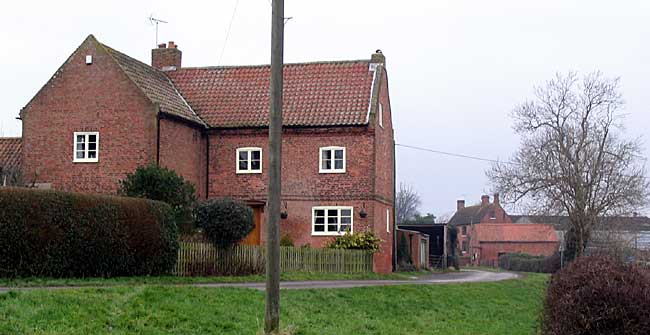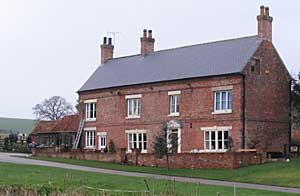Bevercotes

Bevercotes (photo: A Nicholson, 2006).
Small and secluded Bevercotes had its strife and romance
BEVERCOTES is one of those villages whose name proclaims its meaning; it was the home or cote of beavers, and as these animals loved watery abodes it may be assumed that the valley in which the Saxons made their settlement was a marsh. It has ever been one of the smallest of hamlets, and was of so little value at the Conquest that Domesday ignored it, but it is known that it was included in the vast fee of Roger de Busli who had here a manor dependent upon West Markham, held from his successors by the family that took the name of Bevercotes, though they sometimes called it Beverell.
A place so small and secluded is apt to have sparse annals, and it is therefore not surprising that Cornelius Brown in 1888 disposed of it with the mere statement that "apart from the few facts of ownership as recorded by Thoroton there is little or nothing to say about Bevercotes," but the records are not now quite so bare and bald as that, though Thoroton's brief account is still the chief authority up to his time (1677).
King John's Man.
When the Southwell Pentecostal offerings, were instituted, in 1171, the annual contribution from the village was but 8d.—about half the average amount sent by parishes in the Retford Deanery. Under Richard I Robert Beverell participated in John's rebellion, and in 1194, when Coeur de Lion reduced his faithless brother's last strongholds—the castles at Nottingham and Tickhill — the Beverell estates were forfeited to the victor, who, however, returned them to Robert, who was mulcted in a fine, which was not discharged when King Richard died in 1199. By that time the village possessed a church, and when John became King he gave to the Priory of St. Mary at Rouen the royal chapel at Tickhill with all its churches. This gift included the church of West Markham with its chapels-of-ease, of which that here was one.
Robert de Beverell (Bevercotes) was lord of Bevercotes in 1203, and after his death Joan, his widow, paid 20 marks and a palfrey to have possession of land sold to her by Robert before their marriage. Soon afterwards Helewisa, who had married their son and heir, and had been left a widow, had to pay the rapacious John no less than 120 marks and four palfreys that she might not be compelled to wed Peter Burgess as commanded by that king. At this period large estates were being broken up, and (Robt. Beverell's lands became divided, but the chief local lords were the Bevercotes until far into the 16th century, when they were extensive landholders also at W. Markham and elsewhere.
Early in the reign of Henry III Robert de Lexington gave land here to Welbeck Abbey, and about the same time property suits began, Walter de Bevercotes suing Robt. de Willey for the third part of a knight's fee here and at Milton. The defendant was Joan de Bevercotes's second husband, and he seems to have lost the case, for in 1242. William de Bevercotes was in possession of the whole fee, which he held of the Countess of Augi, lady of Tickhill, as his overlord. In that year Blyth Priory had "five small bovates" of land by the gift of Wm. de Bevercotes, and in 1247 this family was granted the right to hunt small game on its lands.
Lawless epoch.
The only notable member of the family was Wm. de Bevercotes, who as Chancellor for Scotland was commanded by Edward I to lead troops to Berwick for his Scottish campaign.
Scenes of disorder marked the time of Edward III. In 1330 Wm. Veysyn was outlawed for a felony; his "lands, tenements, meadows, woods, and rent" here and in W. Drayton were seized by the Crown, which held them for the usual period of a year and a day, and then returned them to William de Elmesley and others whose tenant the outlaw had been. To the knighting of the Black Prince in 1346 Queen Philippa paid 40s. in respect of the manor she held as custodian of the youthful John de Bevercotes, and during her wardship justices were appointed to discover and punish "evildoers and vagabonds who had assaulted her men and tenants, whom they robbed and murdered." It was part of the lawless aftermath of the terrible Black Death of 1349.
The most interesting event of the earlier part of the 15th century was a lengthy lawsuit. In 1411 John and Katherine de Tuxford gave lands here to John de Sutton, and when John died shortly afterwards they resumed possession of the property, and were forthwith sued for one-third of it by Alexander de Meering. The case dragged on for five years, and was ultimately settled by arbitration when Meering was awarded half of what he had claimed. A century later, in 1511, as part of a settlement for the marriage of Cuthbert Bevercotes and Barbara Clerkson, four messuages, two tofts, two cottages, 100a. of land and 22a. of meadow were settled upon them and their heirs, to whom came also the manor of Bevercotes and properties in Elkesley, Milton, W. Markham and Walesby, for which they paid feudal dues including 2s. for the "sheriff's tooth"—a name significant of old-time shrieval exactions—and performed suit at the King's court at Bassetlaw once a year. The last of his line was Cuthbert Bevercotes who, surviving his only son, bestowed his heiress-daughter and her possessions upon Rutland Molyneux and died in 1593.
Suppression of Welbeck.
At some unknown early period, perhaps during the reign of Henry VII, when Thomas Thurland, the great woolstapler, had land here, enclosure commenced, tillage giving way to grazing land for sheep on account of their wool. Another change occurred at the Reformation, when the suppression of Welbeck Abbey and Blyth Prior transferred their properties here into lay hands. In 1550 a Cuthbert Bevercotes was buried in the chancel of the chapel-of-ease, which was dedicated to St. Giles, but in 1559 the quire was "in sore decay." It was a small structure with "a ryng of ii belles and one handbell," and its state went from bad to worse. It figures in Mary Eyre's tapestry map of 1632, but either fell down or was razed about 1650. Since then the few villagers have worshipped in the mother church at West Markham, where a century ago the Duke of Newcastle as lord of the manor was paying an annuity for the provision of seats for their use. To-day a few stones in a garden mark the site of the vanished church.

Farmhouse in Bevercotes (photo: A Nicholson, 2006).
A probable link with the Pilgrim fathers is a Congregational record of 1603 of the marriage in Amsterdam of Thomas Wilson of Beverkorts, bombazine maker, and Jane Cross, of Essex. Another record illustrates the custom of Borough English by which property descended to the youngest son. In 1600 Katherine Short devised to John, her youngest son, and to Thos. Wrigley, her son-in-law, her properties here, &c., leaving small legacies to her elder offspring, to be paid within two years. Rutland Molyneux who in 1609 was accused of being the associate of notorious recusants and of warning a dangerous papist who was to have been seized at Lady Griffin Markham's house, sold Bevercotes to the Earl of Clare, and in 1688 the then earl's steward, Henry Walters, founded a school near the gates of Haughton Park, with an endowment of £27 a year for the education of poor children of Bevercotes and other neighbouring villages in reading, writing, and what the master could manage of grammar."
Noteworthy residents.
Noteworthy residents and owners at this time were a branch of the Denman family and Charles Cornwallis, Esq., who married Faith Clerkson, of Kirton. The famous divine, Richard Baxter, whilst in prison to which Judge Jeffreys had consigned him, received from Gilbert, Earl of Clare, the manor of West Markham with its appurtenances here, but this was merely a legal procedure and two days later the author of "The Saints' Everlasting Rest" granted them back to the earl. In the 18th century the village was studded with the hop-gardens whose produce was famous for its superior quality, and by 1798 the Duke, of Newcastle had planted Farley's Close with ash trees and "laid" Nickhagh's Wood, similarly treated, at Walesby, to his extensive plantations in this parish. In 1801 it numbered 30 inhabitants: a century later it had one less and its maximum population appears to have been 51, but despite its diminutive size of 734 acres and its low rateable value it constitutes a civil parish, comprising some five or six scattered houses, although for ecclesiastical purposes it is merged in the parish of West Markham.
